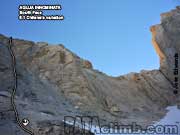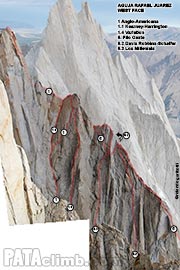Aguja Rafael Juarez - West face
6. Filo Oeste
6.1 Variante Chilensis
6.2 Davis-Robbins - Schaffer
6.3 Los Millenials
700m 6b+
Greg Crouch and Jim Donini (US), 2-3/12/1996 to the Anglo-Americana. Paul McSorley and Jon Walsh (CA) in 2/2005 to the summit.
Description. Starts on the lower left side of the west pillar from where 24 pitches lead to the junction with the Anglo-Americana, 4 pitches from the summit. Seven pitches of mixed climbing lead to the base of two obvious right leaning cracks that split at the first tower on the ridge. Climb the left crack (2 pitches, 6b/A1) and continue up the ridge weaving around the upper towers on the ridge for 12 pitches (mixed climbing and convoluted horizontal route finding). This route was first climbed in “wintery” conditions so repeats can expect to find very different conditions. During the second ascent the route was climbed free at 6b+.
History. Due to serious dehydration and exhaustion the first ascentionists retreated after joining the Anglo-American route, during their second day on the climb. Since they were not able to reach the summit and since they consider that an “alpine route” is not complete unless the summit is reached, Crouch and Donini did not considered it a first ascent and refused to name it. In February 2005 Canadians Paul McSorley and Jon Walsh made the second ascent, first free ascent and first integral ascent of the complete west buttress all the way to the summit. Walsh described his ascent of the route as “a very fun day on great rock.” In 2011 Argentines Flavio "Manzana" Renzacci, Paula Pera and Manuel Quiroga did a "sit start" to this route starting to climb in the slabs right above Polacos adding a further 300 meters of climbing to this already long route.
Solo. On 3/2019, Jim Reynolds (US) free-soloed the complete (sit-start) Filo Oeste (1000m 6b), down-free-soloing the Anglo-Americana (350m 6b). He carried a rope and some gear, which he did not use. He described his approach as the “best possible form of the art” he could come up with. Two days later he free-soloed Aguja Saint Exúpery via Chiaro di Luna (750m 6b+), down-free-soloing the Kearney-Harrington (550m 6a+). A little over a week later he free-soloed the Afanassieff route on Cerro Fitz Roy (1500m, 6a+), taking 6:38hs to reach the summit and 8:30hs to down-free-solo the same route.
In the early 1900s, Austrian Paul Preuss, considered by many “the father of style” had preached and practiced free-soloing up and down peaks as the “honest, sporting” way to climb (his words). He argued that one should “overcome difficulties with your own strength, on ascent and descent alike,” explaining that “if there is someplace you can’t go down, you should also not go up.” One could have never imagined that Preuss's maxims would be one day applied to a peaks like Agujas Rafael Juárez, Saint-Exúpery and Cerro Fitz Roy. One stylistic argument one can make about Jim's ascents is that they are the first free ascents of these formations. If rappels and pendulums are not considered free-climbing in a face such as El Cap, why should an ascent of a jagged peak be considered free unless the descent is also done free?
More info about Jim's free-solo ascents and descents here.
Approach. Polacos.
Descent. Via the Anglo-Americana.
Bibliography. High 176 p. 78; AAJ 1997 p. 252-253.
|
Photos (click to enlarge)
 Aguja Rafael Juarez west face
 Aguja Rafael Juarez west face

Aguja Rafael Juarez west face  Aguja Rafael Juarez west face |
6.1 Variante Chilensis
Jose Edwards and Vicente Espinoza (CL), 12/2011.
Ten new pitches in the south face of the west ridge of Innominata. The climb involves an unprotected 6a+ slab and crack climbing to 6b+ and A0.
History. Jose and Vicente climbed to the Filo Oeste, then along this route for six more pitches to the junction with the Anglo-Americana from where they retreated down the Anglo-Americana. |
6.2 Variante Davis Robbins-Schaffer
Crystal Davis-Robbins and Jonathan Schaffer (US), 1/2015.
Climbs a number of new pitches to reach the west ridge, heading right then, across a knife edge ridge and a crack before heading left and over a bulge. 300 new meters apporx with difficulties to 6b.
|



